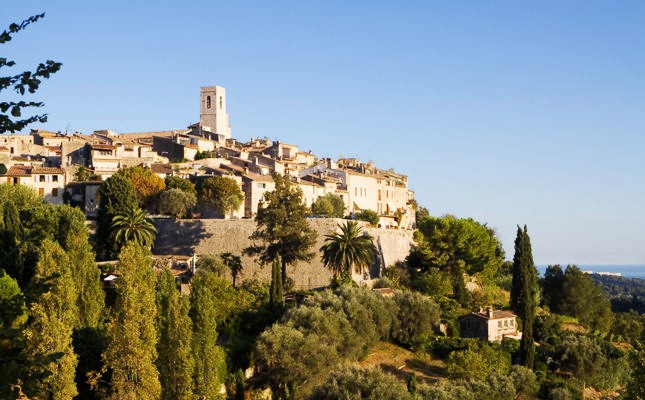[fshow photosetid=72157630616407764]
Located on a hilltop not far from Nice where I was holidaying last summer lies St Paul de Vence. While I had visited Nice and Antibes and Cannes on various occasions this pearl had somehow escaped my attention and I decided to rent a car and explore this charming town which is one of the oldest and best-preserved Medieval towns on the French Rivera.
A young and pretty nurse
St Paul de Vence is blessed with exceptional lights which throughout the years has inspired various artists and painters and the town is still known for its artistic life with an abundance of galleries and art museums. Artists such as Marc Chagall and Bernard Henri Levy and Arielle Dombasle have lived here, but perhaps the most famous of the artists who have called this place home, is Henri Matisse. In 1941 Matisse, who lived most of the year in Nice, underwent surgery for cancer and the story goes that he placed and ad for a “young and pretty nurse” to take care of him while recovering. Monique Bourgeois answered his ad and they embarked on a friendship that was to materialise in the construction of the Chapelle du Rosaire, completed in 1951 after four years of construction.
I visited the chapel on an April day when the sun was high in the sky making the white-washed walls almost unbearable to look at. Located in the outskirts of the ‘new’ Vence, its a short walk away from the charming centre of the old town. Compared to Matisse’s painted works which are commonly bursting with colour and life, the chapel at first comes across as a relatively simple structure void of the artistic talent for which Matisse is known. The walls and structure of the building is reminiscent of the reductivist style of the era.
Works of Matisse
But looks can be deceiving and the chapel is full of other works by Matisse such as the stained glass windows in bright blue, green and yellow colours that give the building life and stands in stark contrast to the white interior and exterior. The chapel is constructed in an L shape with the altar places in the middle. The longer segment is for public use while the shorter section was reserved for the nuns. The altar which is made from brown stone holds bronze candle holders which were also designed by Matisse as were the wrought iron candle holder hanging from the ceiling.
On the walls abstract paintings in black lend the chapel a modern feel and I couldn’t help but think of those paintings that you see in contemporary art museums where you think “I could have done that.” However I found the simplicity of it a welcome relief in the world of religious art and architecture, which I have always found quite overwhelming and intimidating. By the time the interiors of the chapel were to be designed Matisse was an ailing man in a wheel chair and the story goes that he made drafts by attaching a brush to a long stick and painted on paper attached to the wall whereafter the real paintings were made by craftsmen under Matisse’s supervision. One wall is covered in simple streaks resembling flowers while another depicts an image of the Madonna and Child. Behind the altar is a simple, almost child-like depiction of St Dominic made in ceramic tiles. Although Matisse was a baptised Catholic, the Chapelle du Rosaire is devoted to the Order of Dominicans. A couple of year after having met Matisse, Bourgeois became Sister Jacques-Marie at the Dominican convent in Vence and it was through her and the convent that Matisse agreed to start the project.
A love story?
Sister Jacques-Marie insisted to her death in 2004, aged 84, that nothing unduly had ever happened between herself, at the time a young woman, and Matisse an already ageing man. Matisse often spoke of the chapel as his greatest work and referred to Sister Jacques-Marie as the true initiator of the chapel. Matisse died in 1954 just three years after completing the chapel.
Out of all the religious landmarks I’ve visited in southern France, the Chapelle du Rosaire left the biggest impression because of its simplicity and the quaint appeal of the knarly streets of Vence with its galleries and small cafes. Maybe it’s the inherent romantic allure of France but whenever I think back at the Chapelle du Rosaire, I’d like to think of it as a love story between an ailing artist and a young nun.
Vence is home to much more than the Chapelle du Rosaire and walking in the narrow streets of the old town you will come across several historical monuments and points of interest.
- Buy a map and embark on the so-called ‘Historical Walk”. http://saintpaul.pycna.com/Version_G/circuit_saintpauldevence.html
- Rent a car to explore the gems along the Côte d’Azur. Hertz and Europcar are both located on Avenue Gustave in Nice. www.europcar.fr
- Hidden in the shade of an old lime tree and featuring a cozy traditional French terrace, Le Tilleul serves regional French dishes made from seasonal ingredients for lunch and dinner. The traditional Moules Frites with freshly caught mussels from the Mediterranean is delicious.http://www.restaurant-letilleul.com/index.php

